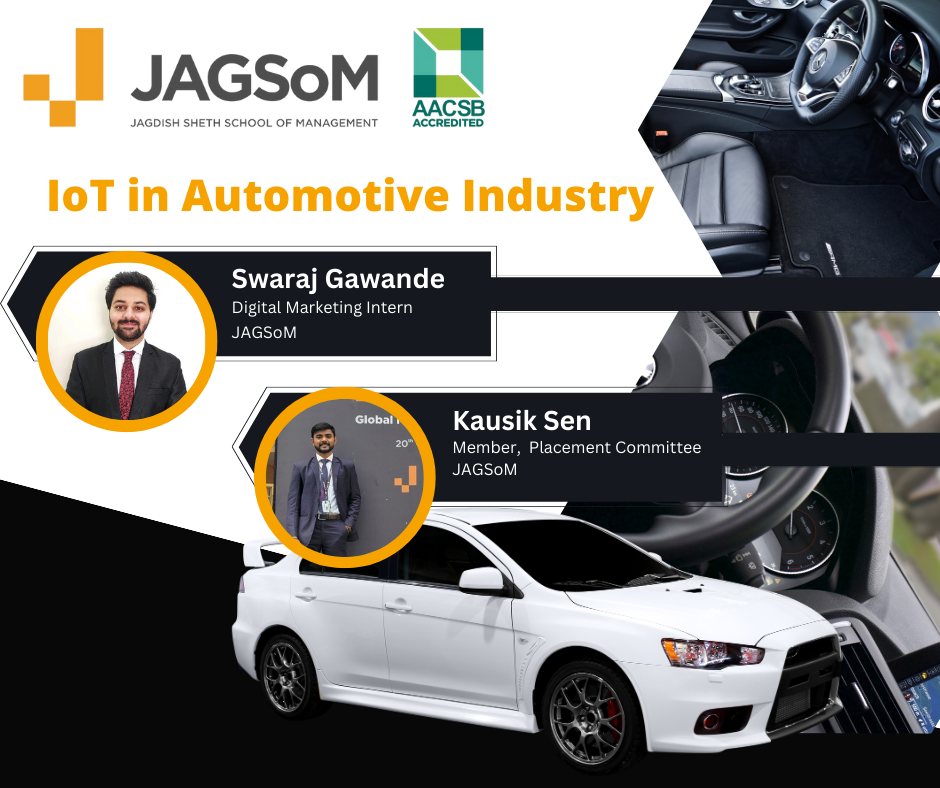Over the past 2 decades the advent of Internet has taken over the entire humanity. Humans and the Internet are closer than ever. The Internet has made our lives significantly easier and simpler.
The Internet of Things or IOT can be considered a gift of the Internet to Humans. The Internet of Things (IOT) is no longer science fiction. It is a rapidly growing network of everyday objects embedded with sensors and software, collecting, and exchanging data. The Internet of Things describes devices with sensors, processing ability, software, and other technologies that connect and exchange data with other devices and systems over the Internet or other communications networks. It encompasses electronics, communication, and computer science engineering.
The Automotive Industry is going through a revolution with the emergence of electric vehicles and Driverless cars, all driven by the ever-increasing integration of the Internet of Things (IOT). IOT creates a network of connected devices that collect and share data.
Let us see how IOT is transforming the automotive industry, bringing benefits to drivers, manufacturers, and the transportation sector as a whole.
Fleet Management

Predictive Maintenance

One of the most exciting benefits of IOT in Automobiles is its ability to constantly monitor vehicular health and signal the driver. IOT is revolutionizing car maintenance. It monitors fuel consumption, brake efficiency engine performance, tyre pressure etc and predicts if the vehicle needs maintenance or not. It helps to avoid unforeseen breakdowns and saves time and money. The use of over-the-air updates and remote diagnostics can also be possible due to the integration of IOT with automobiles. It will automatically resolve the issues even before they occur and also boost the performance of the car.
Connected Cars

Cars are connected to each other over a network called CV2X – Cellular Vehicle to Everything. This is further divided into 4 categories.
- Vehicle to Vehicle
- Vehicle to Infrastructure
- Vehicle to Pedestrians
- Vehicle to Network
This network helps the present and the future as well. This helps the cars communicate with each other to avoid accidents; Communicate with Infrastructure to understand traffic conditions and parking spaces to avoid congestion; Communicate with pedestrians to avoid mishaps and create a collaborative network. After integrating the CV2X technology, the cars can now communicate in real-time which contributes to enhancing the autonomous driving systems and improves the advance road safety as well. The CV2X technology makes it possible for cars to interact with pedestrians and infrastructure through the mode of data exchange. some of the benefits of these revolutionary integrations are reduced traffic congestion, improved urban mobility, and enhanced driving experience, and many more.
Driver Monitoring

Imagine a copilot who watches you behind the wheel, always alert and ready to nudge you back on track. That is the idea behind driver monitoring systems. Using tiny cameras and smart software, these systems keep an eye on you, the driver, to help prevent accidents.
- Distraction Defence: The system can detect dangers like if you are using a phone or feeling sleepy and warn you with alerts like sounds, lights, or even a gentle phone buzz to avoid accidents caused by human error.
- Seatbelt Alert: This system can remind you to put your seatbelt on in case you forget in a rush. It can make sure you are sitting properly for optimal airbag protection.
- Keep track of Passengers: The system will detect if everyone has exited the car, so you do not accidentally forget a sleeping child or pet.
- Overspeeding: This technology will optimize your speed levels and warn you if you are over the limit in specific areas.
The technology is equipped with cutting-edge sensors that closely monitor the driver. The diver monitoring system increases alertness and eliminates all possible hazards while driving. The driver monitoring algorithms will eliminate 100% of chances of the collision on roads. It is said that the integration of this technology in more and more cars leads to optimum road safety and the prevention of accidents. After a little time, roads are safer and driving is more convenient for all drivers.
Traffic Management

With the increasing number of vehicles on the road, managing traffic becomes a chaotic affair. But with the IOT enabled network Traffic is a thing of the past. We can expect a smarter traffic management system with self-driving cars communicating with each other and traffic lights to create a seamless flow of traffic.
The IOT technology leads to the interconnection of cars and infrastructure and has made it possible for cars to real-time exchange data and make decisions. There are several benefits of the technology including the enhanced traffic flow and reduced congestion. Moreover, Self-driving cars promote better traffic management on the roads and it is expected that in the coming years driving will become smoother, more efficient, and safer in the future.
Anti-Theft and Anti-Pollution Measures

IOT is transforming the automotive industry, not just by improving our driving experience but also by making our cars more secure and environmentally friendly.
Anti-Theft Measures:
- Real-time tracking lets you find your car if stolen.
- Geo-fencing tech send alerts if your car leaves a designated area.
- Remote shutdown can disable the engine if theft is suspected.
- Biometric authentication requires a fingerprint or facial scan to start the car.
Anti-Pollution Features:
- IOT sensors monitor your engine to prevent problems that cause harmful emissions.
- Eco-driving apps help you adopt fuel-efficient habits.
- Car to Infrastructure communication allows cars to share traffic data, reducing congestion and emissions.
More importantly, unauthorized entry and vehicle resistance to theft will also improve by several percent due to IOT-based car security solutions. The reduced emission from vehicles will also contribute towards ecologically friendly transportation networks. So, it can be concluded that the impact of IOT on automobile technology will allow the coming generations to enjoy environmental stewardship and enhanced security while driving.
Infotainment & Connectivity

IOT provides multiple infotainment options for users. Starting from music streaming, navigation, voice assistance, hands-free calling, etc. It equips vehicles with NB-IOT and LoRa Technology. Narrowband-IOT and Long-range Technology are useful for expanding the wireless connectivity network for remote tracking, parking assistance and in-car sensors.
To conclude, the integration of IOT in the automotive industry is rapidly transforming the way we drive, maintain, and interact with our vehicles. From enhanced safety features to improved efficiency and the promise of driverless cars, IOT is paving the way for a smarter and more connected automotive future.
References
https://onomondo.com/blog/iot-the-future-of-technology-in-the-automotive-industry/





